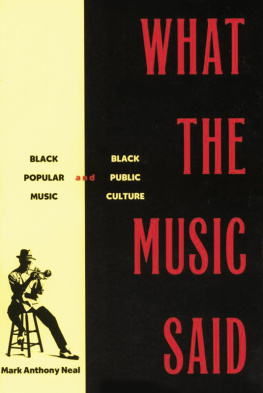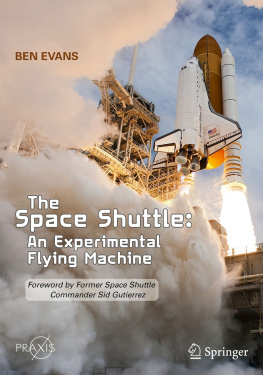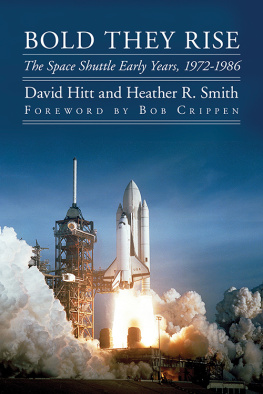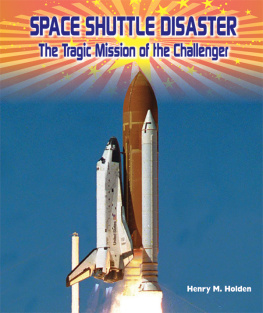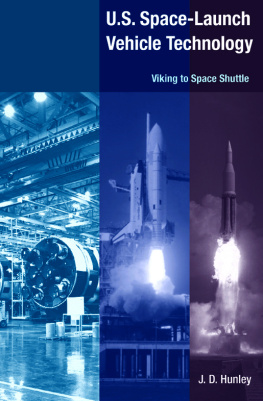Spaceflight in the Shuttle Era and Beyond
Spaceflight in the Shuttle Era and Beyond
Redefining Humanitys Purpose in Space
Valerie Neal
Yale UNIVERSITY PRESS
NEW HAVEN AND LONDON
Yale University Press, in association with the Smithsonian National Air and Space Museum.
Copyright 2017 by the Smithsonian Institution.
All rights reserved.
This book may not be reproduced, in whole or in part, including illustrations, in any form (beyond that copying permitted by Sections 107 and 108 of the U.S. Copyright Law and except by reviewers for the public press), without written permission from the publishers.
Yale University Press books may be purchased in quantity for educational, business, or promotional use. For information, please e-mail (U.K. office).
Set in Adobe Garamond and The Sans types by Newgen North America.
Printed in the United States of America.
Library of Congress Control Number: 2016957558
ISBN 978-0-300-20651-7 (hardcover : alk. paper)
A catalogue record for this book is available from the British Library.
This paper meets the requirements of ANSI/NISO Z39.481992 (Permanence of Paper).
10 9 8 7 6 5 4 3 2 1
To my son
Bryan Guido Hassin
Contents
Preface
A book on spaceflight began to form in my mind when the space shuttle and my career launched simultaneously; my professional life spans the shuttle era. For thirty-plus years, I have worked in various roles on the periphery of the ambitious endeavor of human spaceflight. What has that meant? The question is both biographical and cultural. This book is my effort to discern the cultural meaning of human spaceflightits formation and transformationsin this era.
I completed graduate school in interdisciplinary American studies in the 1970s under the influence of the myth and symbol tradition of intellectual and cultural history. This approach to American culture through the humanities analyzed the history of ideas and their synthesis in literature and the arts to illuminate broad themes in American experience and thought. From the social sciences and history of science came other intellectually fertile concepts for understanding how meaning is created, understood, codified, and modified; paradigm shifts, social construction, framing, and imaginaries entered the scholarly lexicon. Innovative scholarship and analytical trends in humanities and social sciences research continue to invigorate the study of American culture. Conceptual tools and terminology keep changing, but understanding what things mean and how meaning shifts remains a priority.
Educated and predisposed to seek connections between ideas and images, and to read icons as their incarnation, I offer this book in the ever renewing and expanding tradition of culture studies. My focus of inquiry here is a particular American enterprise: human spaceflight in the shuttle era and beyond. In search of its meaning, I explore where answers may be discovered by examining its texts and images and icons, the motives of people and institutions that shaped and spread them, and representations of spaceflight in the broader community. I study its science, technology, and rhetoric. I trace its ebbs and flows and persistence. I approach spaceflight as a cultural text and iconography to be probed and revealed.
Emerging from academics, in the 1980s I worked as a writer-editor under contracts with NASA to support a variety of shuttle missions and science programs. I spent much of my time and energy with mission managers and scientists, jointly creating publications to explain human spaceflight and scientific activities to the public. My job was essentially translation, crafting language and imagery to communicate from a specialized technical world to the world at large. Since I joined the Smithsonian National Air and Space Museum as a space historian and curator in 1989, I have continued such communication with the public through various channels, notably exhibitions and programs about spaceflight. Spending three decades working in space history as it happens is certainly a spur to analysis and reflection.
And so, this book has its origins in my professional experiences where personal narrative intersects with a compelling cultural narrative. Conversant in academic traditions and in spaceflight, I offer here an interdisciplinary perspective on an endeavor that ranges beyond technology, operations, and policy. Human spaceflight means more than that.
Acknowledgments
Throughout this project and others, I have had the benefit of stimulating colleagues at the Smithsonian National Air and Space Museum whose knowledge and interests are an inspiration. First among those whom I credit for influences large and small in our work together, and especially for encouragement of this book, is Michael J. Neufeld, a meticulous researcher, gifted writer, and incisive editor who models the discipline of scholarship in history. Another is Roger D. Launius, a prolific space historian whose range of inquiry is boundless and who writes as easily as breathing. Both have in various ways encouraged my progress on this book, not least by their probing questions and critiques. John R. Dailey, the director of the museum, has also encouraged this effort by expressing his appreciation for the myriad other projects I managed to accomplish at the same time yet nudging this in priority.
The women of the museumthe few female historians and the many women in other roles, past and presenthave offered encouragement in more personal ways. I am grateful for their many gestures of interest and support. These friendly cheerleaders have listened, offered advice, made me laugh, and generously lifted my spirit. I especially appreciate our former publications chief, Patricia J. Graboske, for connecting me with Yale University Press.
Peer reviewers, both known and unknown to me, made fine suggestions that challenged me to think more broadly and deeply about certain aspects of my analysis and steered me to sources I had not yet examined. I greatly appreciate insightful reviews by William P. Barry, Linda Billings, Amy E. Foster, James R. Hansen, Matthew H. Hersch, John M. Logsdon, Howard E. McCurdy, and Ronald L. Pitcock at various stages from initial proposal to final manuscript, as well as the anonymous reviewers solicited by Yale University Press and its editorial review board. All contributed to making this a more solid book; they are, of course, blameless for any shortcomings but may claim a share of any merits of my work.
I conducted much of my research in the NASA Historical Reference Collection in Washington, D.C., whose staff is a national treasure. Jane H. Odom, Colin A. Fries, John H. Hargenrader, and Elizabeth M. Suckow have retrieved countless archival files with dispatch, coached me in the use of their indexes and equipment, and helped bring this book to fruition. The staff of NASAs Johnson Space Center History Archives and the JSC Oral History Project has eased access to those rich collections. Whether searching sources online or in its quiet reading rooms, I am always rewarded by the scope and accessibility of the amazing Library of Congress. Staff of the Ronald Reagan and Richard M. Nixon Presidential Libraries responded helpfully to my inquiries and visits. Constance L. Connie Moore, senior photo researcher at NASA Headquarters, and Mary J. Jody Russell, formerly of the NASA Media Resource Center (photo archives) in Houston, efficiently provided NASA images in proper formats.
The entire National Air and Space Museum Archives and Photography staff helped immensely with illustrations, as did Gregory K. H. Bryant of the registrars office, Jo Ann Morgan of the Space History Department, and Diana Zarick, the Smithsonians licensing attorney. Smithsonian behind-the-scenes volunteer and museum docent Brad Marman, a retired public affairs officer, was a great help in researching news coverage and editorial cartoons, and museum librarian Chris Cottrill found elusive publications. Former NASA executive Alan Ladwig graciously gave me his collection of the agencys publicity materials on the shuttle and space station. I also appreciated the assistance of several undergraduate interns on research tasks, especially Lynn Atkin, Mary Bergman, Vickie Lindsey, Claire Pope, and Jordan Wappler.
Next page


